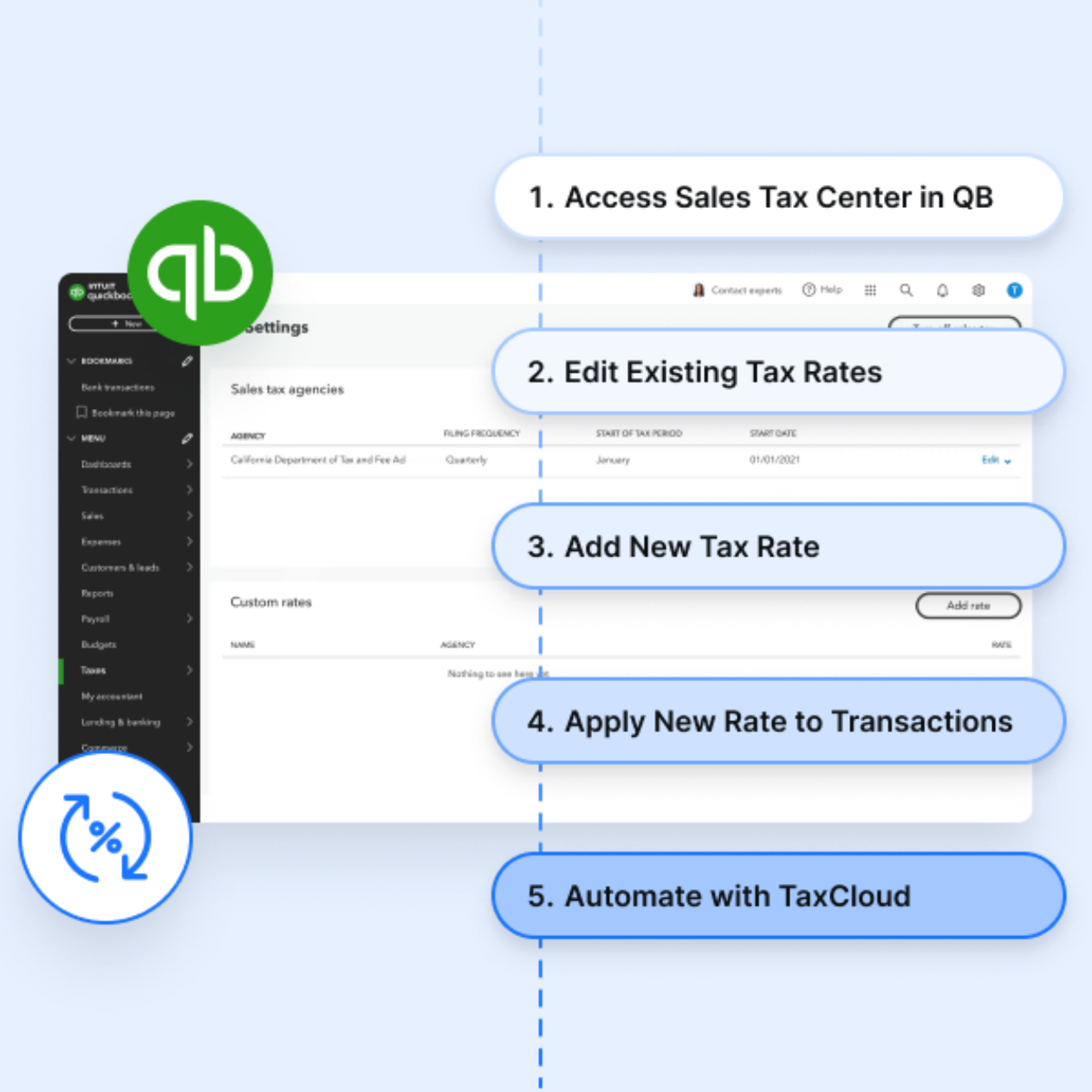
Sales tax compliance is a key part of financial management for businesses. Business owners have to keep their sales tax rates up to date in bookkeeping tools like QuickBooks for accurate tax reporting and compliance with local taxation laws regardless of the setup operating in a single state or in different localities.
We are well aware of how time-consuming and complex updating your tax rates manually can get. But you don’t need to worry as TaxCloud, a cutting-edge accounting software, manages sales tax rates effortlessly so you don’t have to get into that hassle.
It is packed with automation features that provide real-time updates and adjust the tax rate by itself. Say goodbye to the tedious manual work you have to perform for this purpose. The best part? There is a free 30-day trial to see how seamless sales tax management can be when integrated in the system.
This guide will walk you through how to change sales tax rate in QuickBooks in just five easy steps, making sure your tax rates are always accurate and up to date.
Step 1: Access the Sales Tax Center in QuickBooks
The first step in updating your QuickBooks sales tax rate in QuickBooks starts by navigating to the Sales Tax Center. This is the section where your tax rates are managed and organized.
You can access the sales tax center by logging into your QuickBooks account to edit the sales tax rates, Clicking on the “Taxes” tab on the left-hand side of the QuickBooks Dashboard and selecting the “Sales Tax” in the “Taxes” section.
You can view all the sales tax rates associated with your business here in the online app. You can update an existing rate or add a new one.
Step 2: Edit Existing Sales Tax Rates
When governments announce tax rate changes, businesses using QuickBooks may need to update their sales tax rates to ensure compliance. This can be done manually in the Sales Tax Center, where you can locate the rate needing adjustment, click “Edit,” update the tax percentage, and save the changes.
QuickBooks does offer an automated rate calculation option, but many businesses prefer manual updates for more precise control over specific tax rates and compliance needs. Remember, updating a rate will impact future transactions, so it’s wise to verify that past transactions remain accurate unless an update is necessary.
For businesses managing complex tax obligations, this manual approach allows flexibility in handling tax rates across multiple jurisdictions.
Step 3: Add a New Sales Tax Rate
Companies may have to add a new sales tax rate for a different tax jurisdiction when starting their operations into a new area or new tax rules come into effect.
You can add a new sales tax rate in QuickBooks by selecting “New” to create a new tax rate in the Sales Tax Center. Then insert the details of the tax jurisdiction such as the state, city, or county for which the new tax rate applies, and enter the tax rate percentage for the jurisdiction. Save the necessary changes to the new tax rate.
The correct tax will become applicable when you add your custom sales tax rate. However, the process can get complex if your business is set up in multiple states or localities with differing specific tax rates but TaxCloud integration removes the hassle of applying the most recent tax rates automatically.
Step 4: Apply the New Sales Tax Rate to Transactions
Ensuring tax rates are applied to your sales and transactions accurately after they are updated or the addition of the new ones is important. QuickBooks provides personalized help to assign tax rates to specific transactions like invoices or sales receipts.
You can apply revised apply sales tax to a transaction with these simple steps by opening the invoice or sales receipt in QuickBooks, selecting the right tax rate from the drop-down menu in the “Tax” section.
QuickBooks will automatically calculate the correct amount of tax based on the rate you’ve selected. Make sure that revised rate is applicable to all taxable transactions if you have made any recent changes or added a sales tax amount.
Step 5: Automate Sales Tax Changes with TaxCloud
Managing sales tax manually across multiple jurisdictions can become overwhelming for business owners especially if the task has to be performed on a frequent basis. However, TaxCloud integration with QuickBooks makes things fairly simple.
TaxCloud comes with an automated feature that tracks tax rate changes and updates them in QuickBooks in real-time, ensuring that the brand adheres to the local taxation laws.
It seamlessly integrates with QuickBooks by syncing with your account for the sales tax management process. It stands out as a potent tool for tax management in the business world , given that it applies the correct tax rate to each transaction with minimal human intervention.
The software simplifies the entire process, leaving you free to focus on running your business. Plus, with a free 30-day trial, you can test out how easy it is to automate your sales tax changes in QuickBooks.
Final Thoughts
It is important for QuickBooks users to keep their sales tax in QuickBooks updated for accurate tax reporting and compliance with the regulations set by your local tax agency. You can follow the steps outlined in this guide to make sure that everything is in order.
This is where TaxCloud offers a reliable solution. It automates sales tax rate updates and ensures QuickBooks sales tax compliance. You can reduce manual effort, minimize the risk of errors, and stay up to date with changing tax laws by integrating TaxCloud into your workflow.
So what are you waiting for? Get started with a free 30-day trial of TaxCloud today and automate your sales tax changes in QuickBooks.